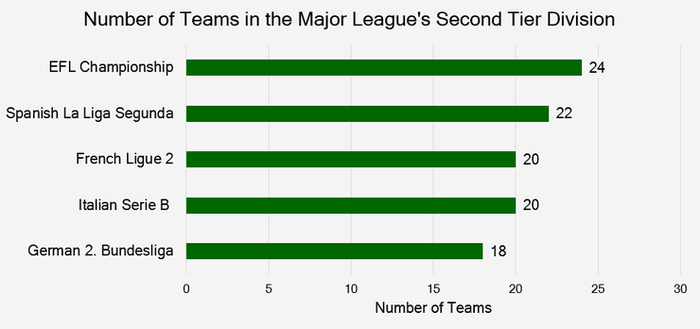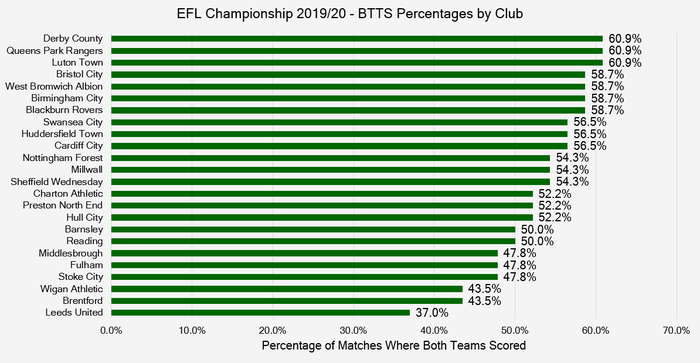
Photo © Kenneth Yarham (cc-by-sa/2.0)
The EFL Championship is the English League’s second tier and boasts some of the highest club football attendance figures in the world, beaten only by the Premier League and German Bundesliga. It is also considered one of the most competitive leagues around with any of the 24 sides capable of beating another on a given matchday. There are plenty of twists and turns in the 46 game regular season, with many of the sides holding a realistic chance of promotion to the Premier League.
Here we give you our betting tips on every match from each round of games to guide you through the season, as well as pointers on who to follow in the outright markets. Previews will be available in the days before games are played.
Championship Format
The EFL Championship is the second tier of professional men’s football in England. Over the years it has had many different names, including the Second Division and, perhaps a little more confusingly, the First Division. The latter name makes sense within the context of the English Football League, with the Championship being the highest level of football within the EFL. The Football League Championship took on its current moniker in 2016 and, to stop everyone from becoming completely confused, we rather hope it sticks to that name!
Structure of the Championship

Call it what you will, but as that famous box to box midfielder (not really!) of ye olde times William Shakespeare said, a rose by any other name would smell as sweet. When it comes to the Championship, old Bill might have said “Division 2 by any other name would still be as fast, frenetic, fiendishly and fiercely competitive and attract crowds the size of which put many of Europe’s other leagues to shame”. Or words to that effect.
We’ve already established that the EFL Championship is the division below the Premier League. Now let’s take a look at its structure, format and some of the keys dates on its calendar. In common with most of the top leagues in Western Europe, the Championship generally runs from August to May. Again, in keeping with most other second tiers, it features promotion and relegation and, as with all levels of UK football, there is, as of 2020-21, no winter break.
For such an important and powerful league, the Championship consists of a lot of teams. A relatively bloated number of 24 sides ply their trade in England’s second tier, whereas, for example, there are only 20 clubs in Serie B at the time of writing and only 18 in the German second division.

Teams play home and away, creating a standard season of 46 games per club and 552 matches in total. At the end of this football marathon, the top two sides gain automatic promotion into the Premier League. The bottom three are relegated into League One, whilst the four clubs finishing third to sixth go into the play-offs.
Championship Play-Offs

Photo © Terry Robinson (cc-by-sa/2.0)
After the regular league has finished there is still one huge prize up for grabs as the best four non-promoted teams battle it out for one final Premier League place. The teams finishing third and sixth, and fourth and fifth, meet home and away in a two-legged play-off semi.
The two sides prevailing in the semis head to Wembley at the end of May to meet in the crucial Championship play-off final. Often dubbed “the richest game in football”, in 2018 it was said that victory for Fulham would be worth at least £160m to the club. That huge figure would rise to a whopping £280m, according to football finance experts Deloitte, if Fulham can stay in the top flight for at least another campaign.
Key Dates
Note that the dates below are based on the 2018-19 EFL Championship. The exact dates will change from season to season but these can be used as a rough guide.
- Fixtures for new season released – 21st August 2020
- Regular season starts – 11th September 2020
- Regular season ends – 8th/9th May 2021
- Play-off final – 29th/31st May 2021
- Summer transfer window opens – 27th July 2020
- Summer window closes for domestic transfers – 16th October 2020 at 5pm
- Summer window closes for international transfers – 5th October 2020 at 11pm
- Loan transfers – available in and out until 16th October 2020 (tbc)
- Winter transfer window – runs from 1st to 31st January 2021
Championship Betting Strategy

Betting on the Championship is huge business. This should come as no surprise because the UK is the world’s biggest regulated gambling market; football is the most wagered on sport in the UK; and the Championship is the second most important division in the UK (apologies to Scottish football, but it’s true!).
The range of markets on the EFL Championship and the overall betting coverage is right up there with the Premier League. There isn’t quite the same depth of markets and betting options but it certainly isn’t far behind.
When it comes to betting on the Championship, most of the tips within our main football betting strategy guide apply. In short, that means that looking for value is key and that studying as much information and data as possible is the best way to try and find bets where the odds are in your favour.
Looking at stats is a great way to try and pick your bets, although it’s always worth remembering that usually the odds are reflective of such publicly available information. None the less, stats and trends are fluid and so if you can get on an emerging trend early you may be able to find some great value whilst the rest of the market – and the bookies – catch up.
Home Advantage

By Andreas Praefcke, Wikimedia Commons
Home advantage is often thought to be a big factor in deciding which team will win. However, the fact of the matter is that the benefit of home advantage has been diminishing steadily for a long time. All the way back in 1896, home sides won a whopping 65% of games in the Football League.
In 2015/16 this had dropped to just 41% over the top four tiers of English football, a relative drop of 37%. In other words, home advantage was over 1/3 less powerful. In the Championship, on average sides win around 48% of their home games if we look at the last few years.
In the 2019/20 season, champions Leeds United won 15 of their 23 home games (65%), as did play-off final winners Fulham. Runners-up West Brom however, won 10 home games that season (43%). Just four sides, Leeds, Fulham, Brentford and Preston, took three points at home in more than half of their games, leaving the other 18 winning less than half of their games on home turf. most sides took three points less than half of the time. Birmingham City and Middlesbrough won just six times at home each where as relegated Hull City picked up the least home points with 24.
Goals

When it comes to Championship football most people think of exciting, end-to-end games with lots of action and goals galore. As said, trends change over time, but looking at the most recent complete campaign, 2019/20, those looking to bet on goals should note the following:
- No goals (0-0 draw) – there were only 31 0-0 draws, landing just in just 5.6% of matches
- Over 0.5 goals – this bet would win 94.4% of the time
- Over 1.5 goals – 73.6% of Championship games last term saw two or more goals
- Over 2.5 – the most popular overs bet landed 49.2% of the time
- Over 3.5 – 26.4% of matches saw four or more goals
- Over 4.5 – back overs here and you would have won 11.8% of your bets
- BTTS – BTTS was a winner in 53.1% of 2019/20 Championship clashes
- Win to nil – 41.3% of games saw a side win to nil
As said, the bookies are usually well aware of the main trends, so you usually have to work a bit harder to uncover some real value. However, it’s worth noting that within overall league trends, you will often find some real outliers in terms of individual teams and if you can get on these early you could well make a killing.
Again, considering the 2019/20 season, whilst both teams scored in over 53% of matches overall, in QPR, Derby and Luton games this figure leaps to almost 61%. At the other end of the scale, “BTTS – no” was a winner in 63% of games involving Champions Leeds United.

Perhaps the most lucrative bet last term was to back over 4.5 goals in Hull’s Championship matches. Hull were poor last term, finishing 18th and they conceded and scored a lot of goals. However, with the odds for over 4.5 goals usually being around the 4/1 mark, even for games where many goals are likely, Hull would have yielded a remarkable return.
Over 4.5 goals was a winner in 20% of Blackburn’s games, almost a quarter. That really was a huge number of high scoring games. The next highest in the Championship was Luton’s 17% and the lowest was Charlton Athletic, with just one their matches seeing five or more goals, the 3-2 home Boxing Day victory over Bristol City.
Stats and Trivia
Want to impress your Championship-loving talking cat with some dandy football stats? Does the future love of your life look like she’d be wooed by a bit of second tier trivia? Or are you just a bit of a football nerd? Whatever your motivation for picking up some Championship trifles, we’ve got 10 great facts sure to wow even the geekiest of geeks!
- Macedonia – the Championship’s appeal is huge and games are broadcast live in Macedonia (not to mention Brazil, Kosovo, South Korea and loads of other countries)
- Dark Days – Rotherham won just 23 points from their 46 games in the 2016-17 campaign
- The Championship is Home – Rotherham’s neighbours Barnsley have spent longer in the second tier than any other side, becoming the first club to play 3,000 games in the division
- Draw Kings – Southampton and Swansea (separately) have both drawn eight games in a row in the Championship
- Double Trouble – when the Second Division, as it was called in 1892, was created, there were 12 clubs, half the current total of 24
- Better Than La Liga and Serie A – not on the pitch but off it, maybe. In the 2016-17 season the Championship was better attended than the top divisions in Spain, Italy and France
- Major But not THAT Major – the Championship’s attendances put it ninth on a list of global leagues in terms of total attendances. However, the 11m aggregate is some way behind the 70m achieved by Major League Baseball!
- Striker – in the Premier League era, the most goals scored in a second tier campaign by a single player is 42. Guy Whittingham achieved that in 1992-93 and the next best is just 31
- Striker MK II – since 2004-05, when the Championship became the Championship, Sylvan Ebanks-Blake is the only player to have been top scorer in more than one season
- Gaffer – in the same era, promotion specialist Neil Warnock has won the Manager of the Month award the most times. Warnock’s 10 were achieved with Cardiff, QPR, Sheffield United, Crystal palace and Rotherham
History

Now we’ve sated you stats fans, let’s give the history buffs a little information on the second rung of the English football ladder. We’ve touched on much of this already but here in chronological order is a concise history of the division.
The Football League Second Division was created in 1892 and operated under that moniker for 100 years until 1992. It came about following a meeting in 1888, at which the director of Aston Villa, a Scotsman called William McGregor, hoped to create an organised league.
The Football League was established following this meeting and soon after the rival, but little known, Football Alliance was also created. In 1892 the two merged, creating the Football League and the Football League Second Division.
Both divisions would have 12 teams and the founder members of the Second Division, nine of whom had been in the lesser Football Alliance, were:
| Club | Year Formed | Home Ground |
|---|---|---|
| Ardwick* | 1880 | Hyde Road |
| Bootle | 1879 | Hawthorne Road |
| Burton Swifts | 1871 | Peel Croft |
| Crewe Alexandra | 1877 | Alexandra Recreation Ground |
| Darwen | 1870 | Barley Bank |
| Grimsby Town | 1878 | Abbey Park |
| Lincoln City | 1884 | John O’Gaunts |
| Northwich Victoria | 1874 | Drill Field |
| Burslem Port Vale | 1876 | Cobridge Athletic Ground |
| Sheffield United | 1889 | Bramall Lane |
| Small Heath** | 1875 | Muntz Street |
| Walsall Town Swifts | 1888 | The Chuckery |
*Ardwick became Manchester City, **Small Heath became Birmingham City
The number of teams in the second tier gradually grew, first going to 15 in its second season, before 16 in 1894. This became 18 in 1898, 20 in 1905, 22 in 1919, 23 in 1987, before settling on the current 24 in 1988.
The exact format of the league has changed very little after promotion and relegation were established relatively early on. There have been some minor changes but the biggest alterations were simply cosmetic.
When the Premier League was created for the 1992-93 season, the Second Division changed its name to the Football League First Division. This lasted until 2004, when the competition became known as the Football League Championship.
In 2016 the Football League took the decision to re-brand as the English Football League and so thus the English Football League Championship was born. But, as you might have heard, a rose by any other name…
